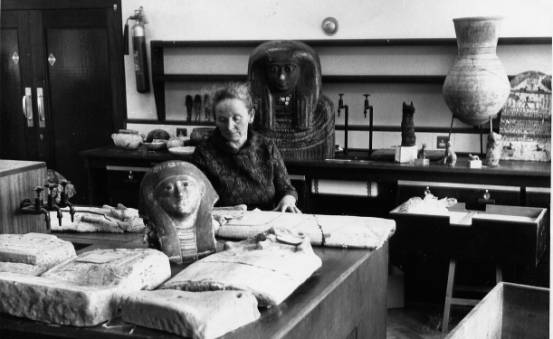History of the Egypt Centre
In 1994 a small Egyptian collection resided in University of Wales, Swansea known and cared or by the Department of Classics and Ancient History and known to academics, but largely unheard of by the general public. Perhaps partly as object-centred teaching was not fashionable, many students of the department studying Egyptology at Swansea had never visited. That year Sybil Crouch, manager of the Taliesin Arts Centre at the University of Wales Swansea, suggested that the collection might be better used. In 1998, sleeping beauty awoke and the Egypt Centre was born – a museum of Egyptian antiquities yes, but also a resource to aid widening participation in Universities, a means of breaking down barriers between town and gown and an inspiration for students, visitors and volunteers. This web-paper attempts to outline a brief history of the collection and how it has been and is used in a University environment.
First a brief resume of the setting up of The Egypt Centre.
 A small collection of classical artefacts had been gathered together prior to the setting up of the Wellcome collection. The outline for how this took place can be read in an article written by Gwyn Griffiths called ‘Museum Efforts Before Wellcome’ which appeared in Inscriptions, December 2000. Among these objects was a bust of Nefertiti, a copy of the famous original in Berlin. This item had been purchased by Prof. George Kerferd from the Berlin State Museums (it is now on display at the entrance of the Egypt Centre). A manuscript in the Egypt Centre archives comments on this proto-museum ‘A man of sound sense in other ways, George Kerferd committed one singular aberration from his normal standards: he thought that the best place to display these objects was outside the staff toilets at the back of the Science Library. He would defend this location by saying that it could hardly be bettered from the point of view of security, since very few students even penetrated to that lonely region’.
A small collection of classical artefacts had been gathered together prior to the setting up of the Wellcome collection. The outline for how this took place can be read in an article written by Gwyn Griffiths called ‘Museum Efforts Before Wellcome’ which appeared in Inscriptions, December 2000. Among these objects was a bust of Nefertiti, a copy of the famous original in Berlin. This item had been purchased by Prof. George Kerferd from the Berlin State Museums (it is now on display at the entrance of the Egypt Centre). A manuscript in the Egypt Centre archives comments on this proto-museum ‘A man of sound sense in other ways, George Kerferd committed one singular aberration from his normal standards: he thought that the best place to display these objects was outside the staff toilets at the back of the Science Library. He would defend this location by saying that it could hardly be bettered from the point of view of security, since very few students even penetrated to that lonely region’.
 The present museum is based upon a selection of items brought together by the pharmacist Sir Henry Wellcome (James 1994; Turner 1980).
The present museum is based upon a selection of items brought together by the pharmacist Sir Henry Wellcome (James 1994; Turner 1980).
The collection has benefitted from the colonialism of the west. More about this here.
When he died in 1936, his collection was cared for by trustees, who were eventually based in London. Much of the collection was dispersed to various museums in Britain, but by the early 1970s some of it remained in the basement of the Petrie Museum. Gwyn Griffiths, lecturer in the Classic Department of University College Swansea (now University of Wales, Swansea), and David Dixon, lecturer in Egyptology at University College London, between them arranged for a selection of the artefacts to come to Swansea. In 1971, ninety-two crates of material arrived in South Wales. These were later supplemented by 48 pottery vases. Kate Bosse-Griffiths, wife of Gwyn Griffiths and an Egyptologist, carefully unpacked them and rediscovered a wealth of objects, some of which were still wrapped in 1930s newspapers. As a determined and indomitable woman, Kate succeeded in setting up a small museum which resided in the Chemistry Department for two years. However, under the patronage of Professor Gould, a small room in the Classics Department soon housed a number of unique and exciting pieces, several of which Kate and others later published. Roger Davies, the Arts Faculty photographer, and his wife assisted Kate in the setting up of the exhibition. David Dixon, as a welsh speaking Welshman had requested that all labels were bilingual. This policy is still adhered to.